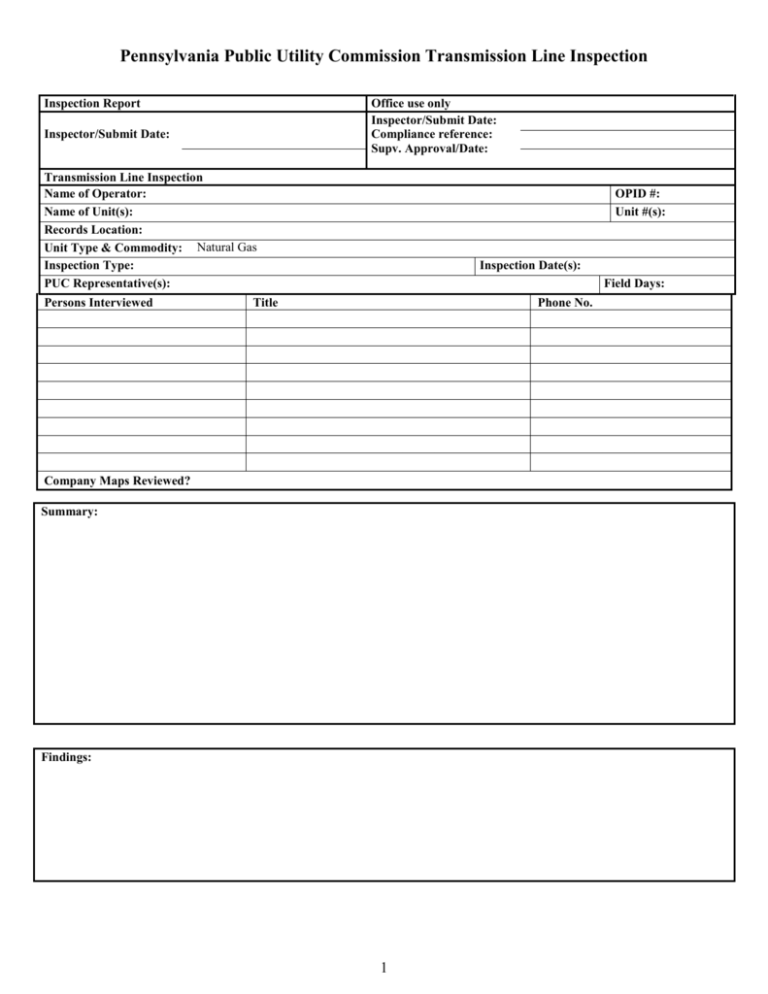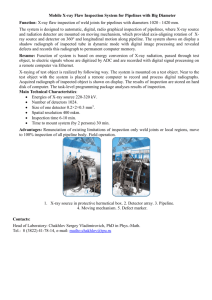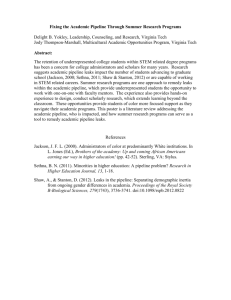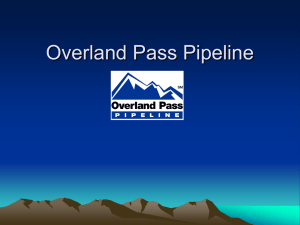Transmission Line Inspection
advertisement

Pennsylvania Public Utility Commission Transmission Line Inspection Inspection Report Office use only Inspector/Submit Date: Compliance reference: Supv. Approval/Date: Inspector/Submit Date: Transmission Line Inspection Name of Operator: Name of Unit(s): Records Location: Unit Type & Commodity: Natural Gas Inspection Type: PUC Representative(s): Persons Interviewed OPID #: Unit #(s): Inspection Date(s): Field Days: Title Phone No. Company Maps Reviewed? Summary: Findings: 1 Pennsylvania Public Utility Commission Transmission Line Inspection Unit Description: Transmission Line Inspected: 2 Pennsylvania Public Utility Commission Transmission Line Inspection List all pipe data for this transmission line: Actual System Operating Pressure: System MAOP: MAOP Method: Install Year Footage Nominal Size Grade Wall Thick- Coating ness Type Outside Diameter SMYS 3 MAOP % SMYS Pressure at MAOP Test Medium Pressure Test Duration Test Pressure Design Pressure Pennsylvania Public Utility Commission Transmission Line Inspection 49 CFR PART 191 REPORTING PROCEDURES .605(b)(4) Procedures for gathering data for incident reporting 191.5 Telephonically reporting incidents to NRC (800) 424-8802 191.15(a) 30-day follow-up written report (Form 7100-2) 191.15(b) Supplemental report (to 30-day follow-up) .605(a) .605(d) 191.23 Reporting safety-related condition (SRCR) 191.25 Filing the SRCR within 5 days of determination, but not later than 10 days after discovery 191.27 Offshore pipeline condition reports – filed within 60 days after the inspections Instructions to enable operation and maintenance personnel to recognize potential Safety Related Conditions 4 S U N/A N/C Pennsylvania Public Utility Commission Transmission Line Inspection 49 CFR PART 192 .13(c) CUSTOMER NOTIFICATION PROCEDURES .16 S U N/A N/C S U N/A N/C S U N/A N/C S U N/A N/C Procedures for notifying new customers, within 90 days, of their responsibility for those selections of service lines not maintained by the operator. .605(a) NORMAL OPERATING and MAINTENANCE PROCEDURES .605(a) O&M Plan review and update procedure (1 per year/15 months) .605(b)(3) Making construction records, maps, and operating history available to appropriate operating personnel .605(b)(5) .605(b)(8) Start up and shut down of the pipeline to assure operation within MAOP plus allowable buildup Periodically reviewing the work done by operator’s personnel to determine the effectiveness and adequacy of the procedures used in normal operation and maintenance and modifying the procedures when deficiencies are found Taking adequate precautions in excavated trenches to protect personnel from the hazards of unsafe accumulations of vapors or gas, and making available when needed at the excavation, emergency rescue equipment, including a breathing apparatus and a rescue harness and line Routine inspection and testing of pipe-type or bottle-type holders Responding promptly to a report of a gas odor inside or near a building, unless the operator’s emergency proced. under §192.615(a)(3) specifically apply to these reports. .605(b)(9) .605(b)(10) .605(b)(11) Comments: .605(a) ABNORMAL OPERATING PROCEDURES (for Transmission companies only) .605(c)(1) Procedures for responding to, investigating, and correcting the cause of: (i) Unintended closure of valves or shut downs (ii) Increase or decrease in pressure or flow rate outside of normal operating limits (iii) Loss of communications (iv) The operation of any safety device .605(c)(2) .605(c)(3) .605(c)(4) (v) Malfunction of a component, deviation from normal operations or personnel error Checking variations from normal operation after abnormal operations ended at sufficient critical locations Notifying the responsible operating personnel when notice of an abnormal operation is received Periodically reviewing the response of operating personnel to determine the effectiveness of the procedures and taking corrective action where deficiencies are found Comments: .605(a) CHANGE in CLASS LOCATION PROCEDURES * .609 Class location study .611 Confirmation or revision of MAOP. Final Rule Pub. 10/17/08, eff. 12/22/08. Comments: 5 Pennsylvania Public Utility Commission Transmission Line Inspection Comments: .613 CONTINUING SURVEILLANCE PROCEDURES .613(a) .613(b) S U N/A N/C S U N/A N/C S U N/A N/C Procedures for surveillance and required actions relating to change in class location, failures, leakage history, corrosion, substantial changes in CP requirements, and unusual operating and maintenance conditions Procedures requiring MAOP to be reduced, or other actions to be taken, if a segment of pipeline is in unsatisfactory condition Comments: .605(a) DAMAGE PREVENTION PROGRAM PROCEDURES .614 Participation in a qualified one-call program, or if available, a company program that complies with the following: (1) Identify persons who engage in excavating (2) Provide notification to the public in the One Call area (3) Provide means for receiving and recording notifications of pending excavations (4) Provide notification of pending excavations to the members (5) (6) Provide means of temporary marking for the pipeline in the vicinity of the excavations Provides for follow-up inspection of the pipeline where there is reason to believe the pipeline could be damaged (i) Inspection must be done to verify integrity of the pipeline (ii) After blasting, a leak survey must be conducted as part of the inspection by the operator Comments: .615 EMERGENCY PROCEDURES .615(a)(1) .615(a)(2) Receiving, identifying, and classifying notices of events which require immediate response by the operator Establish and maintain communication with appropriate public officials regarding possible emergency .615(a)(3) Prompt response to each of the following emergencies: (i) Gas detected inside a building (ii) Fire located near a pipeline (iii) Explosion near a pipeline (iv) Natural disaster .615(a)(4) Availability of personnel, equipment, instruments, tools, and material required at the scene of an emergency .615(a)(5) Actions directed towards protecting people first, then property .615(a)(6) Emergency shutdown or pressure reduction to minimize hazards to life or property 6 Pennsylvania Public Utility Commission Transmission Line Inspection .615 EMERGENCY PROCEDURES .615(a)(7) Making safe any actual or potential hazard to life or property .615(a)(8) Notifying appropriate public officials required at the emergency scene and coordinating planned and actual responses with these officials .615(a)(9) Instructions for restoring service outages after the emergency has been rendered safe .615(a)(10) Investigating accidents and failures as soon as possible after the emergency .615(b)(1) Furnishing applicable portions of the emergency plan to supervisory personnel who are responsible for emergency action Training appropriate employees as to the requirements of the emergency plan and verifying effectiveness of training .615(b)(2) .615(b)(3) Reviewing activities following emergencies to determine if the procedures were effective .615(c) Establish and maintain liaison with appropriate public officials, such that both the operator and public officials are aware of each other’s resources and capabilities in dealing with gas emergencies S U N/A N/C Comments: PUBLIC AWARENESS PROGRAM PROCEDURES (Also in accordance with API RP 1162) .605(a) * .616 .616(d) S U N/A N/C Public Awareness Program also in accordance with API RP 1162. Amdt 192-99 pub. 5/19/05 eff. 06/20/05. The operator's program must specifically include provisions to educate the public, appropriate government organizations, and persons engaged in excavation related activities on: (1) Use of a one-call notification system prior to excavation and other damage prevention activities; (2) Possible hazards associated with unintended releases from a gas pipeline facility; (3) Physical indications of a possible release; (4) Steps to be taken for public safety in the event of a gas pipeline release; and (5) Procedures to report such an event (to the operator). .616(e) .616(f) .616(g) The operator’s program must include activities to advise affected municipalities, school districts, businesses, and residents of pipeline facility locations. The operator’s program and the media used must be comprehensive enough to reach all areas in which the operator transports gas. The program conducted in English and any other languages commonly understood by a significant number of the population in the operator's area? Comments: .617 FAILURE INVESTIGATION PROCEDURES .617 Analyzing accidents and failures including laboratory analysis where appropriate to determine cause and prevention of recurrence Comments: 7 S U N/A N/C Pennsylvania Public Utility Commission Transmission Line Inspection Comments: .605(a) MAOP PROCEDURES S U N/A N/C S U N/A N/C Note: If the operator is operating at 80% SMYS with waivers, the inspector needs to review the special conditions of the waivers. .619 Establishing MAOP so that it is commensurate with the class location * MAOP cannot exceed the lowest of the following: (a)(1) Design pressure of the weakest element, Amdt. 192-103 pub. 06/09/06, eff. 07/10/06 (a)(2) Test pressure divided by applicable factor (a)(3) The highest actual operating pressure to which the segment of line was subjected during the 5 years preceding the applicable date in second column, unless the segment was tested according to .619(a)(2) after the applicable date in the third column or the segment was uprated according to subpart K. Amdt 192-102 pub. 3/15/06, eff. 04/14/06. For gathering line related compliance deadlines and additional gathering line requirements, refer to Part 192 including this amendment. * Pipeline segment --Onshore gathering line that first became subject to this part (other than § 192.612) after April 13, 2006. -- Onshore transmission line that was a gathering line not subject to this part before March 15, 2006. Offshore gathering lines. All other pipelines. Pressure date March 15, 2006, or date line becomes subject to this part, whichever is later. July 1, 1976. July 1, 1970. Test date 5 years preceding applicable date in second column. July 1, 1971. July 1, 1965. (a)(4) Maximum safe pressure determined by operator. (b) Overpressure protective devices must be installed if .619(a)(4) is applicable * .620 * (c) The requirements on pressure restrictions in this section do not apply in the following instance. An operator may operate a segment of pipeline found to be in satisfactory condition, considering its operating and maintenance history, at the highest actual operating pressure to which the segment was subjected during the 5 years preceding the applicable date in the second column of the table in paragraph (a)(3) of this section. An operator must still comply with § 192.611. Amdt 192-102 pub. 3/15/06, eff. 04/14/06. For gathering line related compliance deadlines and additional gathering line requirements, refer to Part 192 including this amendment. If the pipeline is designed to the alternative MAOP standard in 192.620 does it meet the additional design requirements for: General standards Fracture control Plate and seam quality control Mill hydrostatic testing Coating Fittings and flanges Compressor stations Final Rule Pub. 10/17/08, eff. 12/22/08. Comments: .13(c) PRESSURE TEST PROCEDURES .503 Pressure testing 8 Pennsylvania Public Utility Commission Transmission Line Inspection Comments: .13(c) UPRATING PROCEDURES S U N/A N/C ODORIZATION of GAS PROCEDURES S U N/A N/C S U N/A N/C S U N/A N/C S U N/A N/C .553 Uprating Comments: .605(a) .625(b) Odorized gas in Class 3 or 4 locations (if applicable) – must be readily detectable by person with normal sense of smell at 1/5 of the LEL .625(f) Periodic gas sampling, using an instrument capable of determining the percentage of gas in air at which the odor becomes readily detectable. .627 Hot taps must be made by a qualified crew Comments: .605(a) TAPPING PIPELINES UNDER PRESSURE PROCEDURES NDT testing is suggested prior to tapping the pipe. Reference API RP 2201 for Best Practices. .605(a) PIPELINE PURGING PROCEDURES .629 Purging of pipelines must be done to prevent entrapment of an explosive mixture in the pipeline (a) Lines containing air must be properly purged. (b) Lines containing gas must be properly purged Comments: .605(a) MAINTENANCE PROCEDURES .703(b) (c) Each segment of pipeline that becomes unsafe must be replaced, repaired, or removed from service Hazardous leaks must be repaired promptly Comments: 9 Pennsylvania Public Utility Commission Transmission Line Inspection .605(b) TRANSMISSION LINES - PATROLLING & LEAKAGE SURVEY PROCEDURES .705(a) (b) .706 S U N/A N/C S U N/A N/C S U N/A N/C S U N/A N/C Patrolling ROW conditions Maximum interval between patrols of lines: Class Location At Highway and Railroad Crossings At All Other Places 1 and 2 2/yr (7½ months) 1/yr (15 months) 3 4/yr (4½ months) 2/yr (7½ months) 4 4/yr (4½ months) 4/yr (4½ months) Leakage surveys – 1 year/15 months Leak detector equipment survey requirements for lines transporting un-odorized gas (a) Class 3 locations - 7½ months but at least twice each calendar year (b) Class 4 locations - 4½ months but at least 4 times each calendar year Comments: .605(b) LINE MARKER PROCEDURES .707 Line markers installed and labeled as required Comments: .605(b) RECORD KEEPING PROCEDURES .709 Records must be maintained… (a) Repairs to the pipe – life of system (b) Repairs to “other than pipe” – 5 years (c) Operation (Sub L) and Maintenance (Sub M) patrols, surveys, tests – 5 years or until next one Comments: .605(b) FIELD REPAIR PROCEDURES Imperfections and Damages .713(a) Repairs of imperfections and damages on pipelines operating above 40% SMYS (1) Cut out a cylindrical piece of pipe and replace with pipe of ≥ design strength (2) Use of a reliable engineering method .713(b) Reduce operating pressure to a safe level during the repair Permanent Field Repair of Welds .715 Welds found to be unacceptable under §192.241(c) must be repaired by: 10 Pennsylvania Public Utility Commission Transmission Line Inspection .605(b) FIELD REPAIR PROCEDURES S U N/A N/C S U N/A N/C S U N/A N/C (a) If feasible, taking the line out of service and repairing the weld in accordance with the applicable requirements of §192.245. (b) If the line remains in service, the weld may be repaired in accordance with §192.245 if: (1) The weld is not leaking (2) The pressure is reduced to produce a stress that is 20% of SMYS or less (3) Grinding is limited so that ⅛ inch of pipe weld remains (c) If the weld cannot be repaired in accordance with (a) or (b) above, a full encirclement welded split sleeve must be installed Permanent Field Repairs of Leaks .717 Field repairs of leaks must be made as follows: (a) Replace by cutting out a cylinder and replace with pipe similar or of greater design (b)(1) Install a full encirclement welded split sleeve of an appropriate design unless the pipe is joined by mechanical couplings and operates at less than 40% SMYS (b)(2) A leak due to a corrosion pit may be repaired by installing a bolt on leak clamp (b)(3) For a corrosion pit leak, if a pipe is not more than 40,000 psi SMYS, the pits may be repaired by fillet welding a steel plate. The plate must have rounded corners and the same thickness or greater than the pipe, and not more than ½D of the pipe size (b)(4) Submerged offshore pipe or pipe in inland navigable waterways may be repaired with a mechanically applied full encirclement split sleeve of appropriate design (b)(5) Apply reliable engineering method .719(a) (b) Testing of Repairs Replacement pipe must be pressure tested to meet the requirements of a new pipeline For lines of 6-inch diameter or larger and that operate at 20% of more of SMYS, the repair must be nondestructively tested in accordance with §192.241(c) Comments: .605(b) ABANDONMENT or DEACTIVATION of FACILITIES PROCEDURES .727(b) (c) (d) (e) * .727 (g) Operator must disconnect both ends, purge, and seal each end before abandonment or a period of deactivation where the pipeline is not being maintained. Offshore abandoned pipelines must be filled with water or an inert material, with the ends sealed Except for service lines, each inactive pipeline that is not being maintained under Part 192 must be disconnected from all gas sources/supplies, purged, and sealed at each end. Whenever service to a customer is discontinued, do the procedures indicate one of the following: (1) The valve that is closed to prevent the flow of gas to the customer must be provided with a locking device or other means designed to prevent the opening of the valve by persons other than those authorized by the operator (2) A mechanical device or fitting that will prevent the flow of gas must be installed in the service line or in the meter assembly (3) The customer’s piping must be physically disconnected from the gas supply and the open pipe ends sealed If air is used for purging, the operator shall ensure that a combustible mixture is not present after purging Operator must file reports upon abandoning underwater facilities crossing navigable waterways, including offshore facilities. Amdt. 192-103 corr. pub 02/01/07, eff. 03/05/07. .605(b) VALVE AND VAULT MAINTENANCE PROCEDURES Valves 11 Pennsylvania Public Utility Commission Transmission Line Inspection .605(b) VALVE AND VAULT MAINTENANCE PROCEDURES S U N/A N/C S U N/A N/C (a) Each transmission line, other than offshore segments, must have sectionalizing block valves spaced as follows, unless in a particular case the Administrator finds that alternative spacing would provide an equivalent level of safety: .179 .745 .745 .605(b) (1) Each point on the pipeline in a Class 4 location must be within 2 1/2 miles (4 kilometers) of a valve. (2) Each point on the pipeline in a Class 3 location must be within 4 miles (6.4 kilometers) of a valve. (3) Each point on the pipeline in a Class 2 location must be within 7 1/2 miles (12 kilometers) of a valve. (4) Each point on the pipeline in a Class 1 location must be within 10 miles (16 kilometers) of a valve. (b) Each sectionalizing block valve on a transmission line, other than offshore segments, must comply with the following: (1) The valve and the operating device to open or close the valve must be readily accessible and protected from tampering and damage. (2) The valve must be supported to prevent settling of the valve or movement of the pipe to which it is attached. (c) Each section of a transmission line, other than offshore segments, between main line valves must have a blowdown valve with enough capacity to allow the transmission line to be blown down as rapidly as practicable. Each blowdown discharge must be located so the gas can be blown to the atmosphere without hazard and, if the transmission line is adjacent to an overhead electric line, so that the gas is directed away from the electrical conductors. (d) Offshore segments of transmission lines must be equipped with valves or other components to shut off the flow of gas to an offshore platform in an emergency. (a) Inspect and partially operate each transmission valve that might be required during an emergency (1 per yr/15 months) (b) Prompt remedial action required, or designate alternative valve. PREVENTION of ACCIDENTAL IGNITION PROCEDURES .751 Reduce the hazard of fire or explosion by: (a) Removal of ignition sources in presence of gas and providing for a fire extinguisher (b) Prevent welding or cutting on a pipeline containing a combustible mixture (c) Post warning signs Comments: 12 Pennsylvania Public Utility Commission Transmission Line Inspection Note: Was the Welding inspection form for welding and NDT completed? Was the Plastic Construction inspection form for plastic lines completed? Was the Corrosion inspection form for corrosion control inspection completed? Was the Public Awareness Program Inspection form completed? .801.809 Subpart N — Qualification of Pipeline Personnel Procedures S U N/A N/C S U N/A N/C S U N/A N/C Complete OQ Protocol 9 form for any field inspections. .901.951 Subpart O — Pipeline Integrity Management Complete the Pipeline Integrity Field Inspection form. Subparts A-C PART 199 – DRUG and ALCOHOL TESTING REGULATIONS and PROCEDURES Drug & Alcohol Testing & Alcohol Misuse Prevention Program – Use PHMSA Form # 13, PHMSA 2008 Drug and Alcohol Program Check. Comments: PIPELINE INSPECTION (Field) .179 (a) .179 (b) .179 (c) .479 .605 .605 Valve spacing: Class 4 locations--2 1/2 miles Class 3 locations--4 miles Class 2 locations --7 1/2 miles Class 1 locations--10 miles (1) The valve readily accessible and protected from tampering and damage. (2) The valve must be supported to prevent settling of the valve or movement of the pipe to which it is attached. Blowdown valves located between mainline valves with sufficient capacity to relieve pressure rapidly and in safe manner. Pipeline Components Exposed to the Atmosphere Knowledge of Operating Personnel List all SRC’s reported on this pipeline since last inspection Date Results 613(b), .703 Pipeline condition, unsatisfactory conditions, hazards, etc. .707 .745 ROW Markers, Road and Railroad Crossings Pressure Limiting and Regulating Devices to protect system from Supplier at Take Station (spot-check field installed equipment vs. inspection records) Valve Maintenance .751 Warning Signs .801 - .809 Operator Qualification - Use PHMSA Form 15 Operator Qualification Field Inspection Protocol Form .739/.743 Comments: 13 S U N/A N/C Pennsylvania Public Utility Commission Transmission Line Inspection CONVERSION TO SERVICE PERFORMANCE and RECORDS .14 (a)(2) (a)(3) Correction of unsafe defects and conditions (a)(4) Pipeline testing in accordance with Subpart J (b) Pipeline records: investigations, tests, repairs, replacements, alterations (life of pipeline) REPORTING PERFORMANCE and RECORDS 191.5 Telephonic reports to NRC (800-424-8802) 191.15 Written incident reports; supplemental incident reports (DOT Form RSPA F 7100.2) 191.17 (a) Annual Report (DOT Form RSPA F 7100.2-1) 191.23 Safety related condition reports .225 Test Results to Qualify Welding Procedures .227 Welder Qualification .241 (a) Visual Weld Inspector Training/Experience .243 (b)(2) Nondestructive Technician Qualification CONSTRUCTION PERFORMANCE and RECORDS (c) (f) NDT procedures Total Number of Girth Welds (f) Number of Welds Inspected by NDT (f) Number of Welds Rejected (f) Disposition of each Weld Rejected .303 Construction Specifications .325 Underground Clearance Amount, Location, Cover of each Size of Pipe Installed .327 .328 .455 U N/A N/C S U N/A N/C S U N/A N/C S U N/A N/C If the pipeline will be operated at the alternative MAOP standard calculated under 192.620 (80% SMYS) does it meet the additional construction requirements for: Quality assurance, Girth welds, depth of cover, initial strength testing, and interference currents? Cathodic Protection OPERATIONS and MAINTENANCE PERFORMANCE and RECORDS Customer Notification (Verification – 90 days – and Elements) .16 .603(b) .605(a) Procedural Manual Review – Operations and Maintenance (1 per yr/15 months) .603(b) .605(c) Abnormal Operations (for transmission companies only) .603(b) .605(b)(3) Availability of construction records, maps, operating history to operating personnel .603(b) .605(b)(8) .605(c)(4) .709 .609 Periodic review of personnel work – effectiveness of normal O&M procedures Periodic review of personnel work – effectiveness of abnormal operation procedures (for transmission companies only) Class Location Study (If Applicable) .709 .614 Damage Prevention (Miscellaneous) .603(b) .615(b)(1) Location Specific Emergency Plan .603(b) .615(b)(2) Emergency Procedure training, verify effectiveness of training .603(b) .615(b)(3) Employee Emergency activity review, determine if procedures were followed. .603(b) .615(c) Liaison Program with Public Officials .603(b) S Visual inspection of right of way, aboveground and selected underground segments .517 Pressure Testing .553(b) Uprating .709 .619 / .620 Maximum Allowable Operating Pressure (MAOP) .709 .625 Odorization of Gas 14 Pennsylvania Public Utility Commission Transmission Line Inspection OPERATIONS and MAINTENANCE PERFORMANCE and RECORDS .709 .705 Patrolling (Refer to Table Below) Class Location 1 and 2 3 4 .709 .706 S At Highway and Railroad Crossings 2/yr (7½ months) 4/yr (4½ months) 4/yr (4½ months) At All Other Places 1/yr (15 months) 2/yr (7½ months) 4/yr (4½ months) Leak Surveys (Refer to Table Below) Required Class Location 1 and 2 1/yr 3 2/yr* 4 4/yr* * Leak detector equipment survey required for lines transporting un-odorized gas. Comments: 15 Not Exceed 15 months 7½ months 4½ months U N/A N/C






